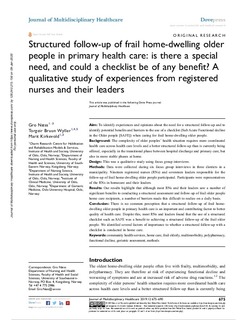| dc.contributor.author | Næss, Gro | |
| dc.contributor.author | Wyller, Torgeir Bruun | |
| dc.contributor.author | Kirkevold, Marit | |
| dc.date.accessioned | 2020-01-15T13:46:51Z | |
| dc.date.available | 2020-01-15T13:46:51Z | |
| dc.date.created | 2019-12-03T13:02:05Z | |
| dc.date.issued | 2019 | |
| dc.identifier.citation | Journal of Multidisciplinary Healthcare. 2019, 12, 675-690. | nb_NO |
| dc.identifier.issn | 1178-2390 | |
| dc.identifier.uri | http://hdl.handle.net/11250/2636465 | |
| dc.description | This work is published and licensed by Dove Medical Press Limited. The full terms of this license are available at and incorporate the Creative Commons Attribution – Non Commercial (unported, v3.0) License. By accessing the work you hereby accept the Terms. Non-commercial uses of the work are permitted without any further permission from Dove Medical Press Limited, provided the work is properly attributed. For permission for commercial use of this work, please see paragraphs 4.2 and 5 of our Terms | nb_NO |
| dc.description.abstract | Aim: To identify experiences and opinions about the need for a structured follow-up and to identify potential benefits and barriers to the use of a checklist (Sub Acute Functional decline in the Older people [SAFE]) when caring for frail home-dwelling older people.
Background: The complexity of older peoples’ health situation requires more coordinated health care across health care levels and a better structured follow-up than is currently being offered, especially in the transitional phase between hospital discharge and primary care, but also in more stable phases at home.
Design: This was a qualitative study using focus group interviews.
Methods: Data were collected during six focus group interviews in three districts in a municipality. Nineteen registered nurses (RNs) and seventeen leaders responsible for the follow-up of frail home-dwelling older people participated. Participants were representatives of the RNs in homecare and their leaders.
Results: Our results highlight that although most RNs and their leaders saw a number of significant benefits to conducting a structured assessment and follow-up of frail older people home care recipients, a number of barriers made this difficult to realize on a daily basis.
Conclusion: There is no common perception that a structured follow-up of frail home-dwelling older people in primary health care is an important and contributing factor to better quality of health care. Despite this, most RNs and leaders found that the use of a structured checklist such as SAFE was a benefit to achieving a structured follow-up of the frail older people. We identified several factors of importance to whether a structured follow-up with a checklist is conducted in home care. | nb_NO |
| dc.language.iso | eng | nb_NO |
| dc.rights | Navngivelse-Ikkekommersiell 4.0 Internasjonal | * |
| dc.rights.uri | http://creativecommons.org/licenses/by-nc/4.0/deed.no | * |
| dc.title | Structured follow-up of frail home-dwelling older people in primary health care: Is there a special need, and could a checklist be of any benefit? A qualitative study of experiences from registered nurses and their leaders | nb_NO |
| dc.type | Journal article | nb_NO |
| dc.type | Peer reviewed | nb_NO |
| dc.description.version | publishedVersion | nb_NO |
| dc.rights.holder | © 2019 Næss et al. | nb_NO |
| dc.source.pagenumber | 675-690 | nb_NO |
| dc.source.volume | 12 | nb_NO |
| dc.source.journal | Journal of Multidisciplinary Healthcare | nb_NO |
| dc.identifier.doi | 10.2147/JMDH.S212283 | |
| dc.identifier.cristin | 1756041 | |
| cristin.unitcode | 222,56,1,0 | |
| cristin.unitname | Institutt for sykepleie- og helsevitenskap | |
| cristin.ispublished | true | |
| cristin.fulltext | original | |
| cristin.qualitycode | 1 | |

